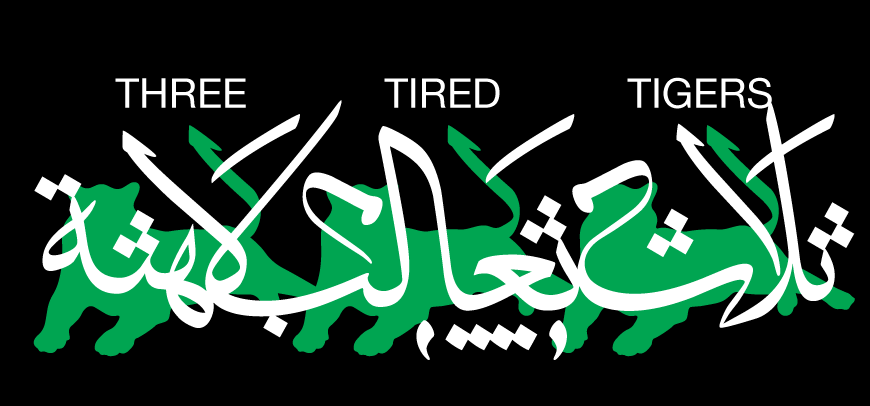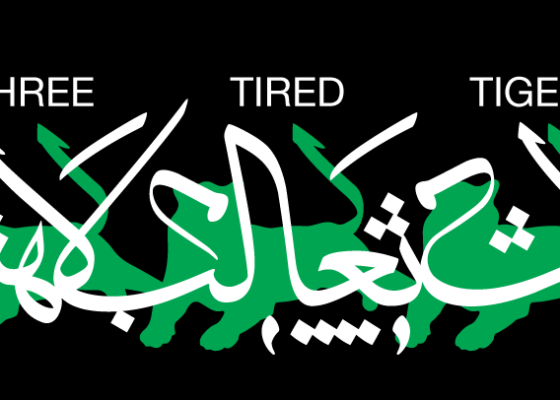Join us for a series of conversations with artists and contributors marking the opening of the ‘Three Tired Tigers’ exhibition. Artists and researchers will come together to delve into the often-overlooked presence of animals in urban landscapes.
4 pm – On the work of Mohieddine Ellabbad
Moe Elhossieny (Arabic Design Archive) and Ahmed Ellabbad
Moderated by Uns Kattan
In Arabic
This conversation brings together Moe Elhossieny and Ahmed Ellabbad along with Art Jameel’s Uns Kattan, Head of Learning and Research to reflect on the legacy of the revered Egyptian illustrator and bookmaker Mohieddine Ellabbad. Ellabad co-founded Dar al-Fata al-Arabi, a children’s book publisher established in Beirut in 1974 that published over sixty books during its time in operation. Ellabbad’s work is featured in the Three Tired Tigers exhibition with the help of the Arabic Design Archive.
5 pm – Artist Talks: Kasper Bosmans, Annika Eriksson, Walid Siti
Moderated by Lucas Morin
In English
In dialogue with Art Jameel’s Senior Curator, Lucas Morin, artists Kasper Bosmans, Annika Eriksson and Walid Siti will reflect on their exhibited works, their processes and the intersections of urban and animal life in the region.
6 pm – Opening reception of Three Tired Tigers
About the speakers
Moe Elhossieny is a multidisciplinary design/creative director and writer from Cairo, Egypt. His expertise spans advertising, bilingual design, research, and creative writing, forming a unique approach to communication design. In 2020, he founded the Design Repository, a platform for publishing Arabic graphic design, and launched the Arabic Design Archive, now the largest digital archive of Arabic graphic design, featuring over 8,000 works from the 1930s to 1990s.
Ahmed Ellabad (b. 1967, in Cairo, Egypt) is an Egyptian visual artist specializing in editorial graphics. Allabad uses various media in his work, including drawing, manual printing, photography, and draws inspiration from Arabic calligraphy, collage, and more. He has a deep interest in both local and global artistic heritage, as well as in contemporary visual references, blending all these elements into liberated visual scenarios. His paintings have been exhibited both in Egypt and abroad, with collections of his works held in Egypt and internationally, including in the Museum of Modern Art in Cairo.
Kasper Bosmans (b. 1990 in Lommel, Belgium) Known for his multifaceted and divergent approach to art making, with works that range from sculpture and installation to painting and drawing, Bosmans’ practice is a complex concoction of high art and literature, popular culture, mythology and anthropology. Bosmans prods, pokes and teases out connections in his work that are significant to his personal world, but the resulting narratives cannot help but take on a universal resonance.
Walid Siti (b. 1954, in Duhok, in Iraqi-Kurdistan) Formerly trained in printmaking, Siti works extensively in a variety of mediums including video, installation, 3D works, work on paper and painting. His works traverse a complex terrain of memory and loss, while at the same time offering an acute insight into a world, which for him has been a place of constant change. The artist’s work considers the tensions between collective identity, interdependence and the constraints placed on the individual by themes of heritage, tradition, homes, borders, mobility and migration.
Annika Eriksson (b. 1956 in Malmö, Sweden) is a contemporary artist known for her multimedia installations and video works that often explore social interactions, the nature of public space, and the dynamics within communities. Eriksson’s practice is characterised by a participatory approach, where she frequently involves the public or specific groups of people in the creation of her art, blurring the lines between artist and audience. Annika is here with the support of IASPIS, the Swedish Arts Grants Committee´s International Programme for Visual and Applied Arts.
SEE ALL EVENTS
